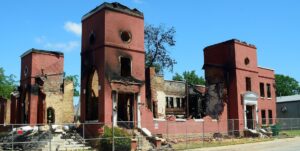
Upskilling California
Californians aren’t new to disaster. Just in the past five years, the State has experienced over 70 significant calamities, including wildfires, earthquakes, storms, landslides, and floods. While each incident costs the state millions (sometimes billions) in recovery funding, collectively, the events build a strong case to develop a more resilient and sturdy infrastructure that can better withstand these onslaughts.
An enhanced, more pliable infrastructure is Governor Newsom’s plan, too, which he initiated on his very first day in office. Back in 2019, he announced that ’emergency preparedness’ was the top goal for his administration, and that he would prioritize the statewide development and implementation of disaster response and recovery systems. In the intervening years, Newsom has been true to his word, and California is now heavily invested in reconfiguring its foundations and systems to better manage whatever cataclysm Mother Nature chooses to throw at it next.
Newsom’s Executive Order N-4-19
As evidence of his intent, Newsom’s Executive Order N-4-19 (EO4) directs the State to revise its approach to potential threats, with the intent to improve both its preparedness and response capacities.
This directive is extraordinary in that it mandates a complete overhaul of the process for how California procures services and achieves goals. Newsom pivoted away from following the traditional path of selecting, then ordering specific assets to apply to a specific problem. Instead, he proposed a new procurement method: the ‘Request for Innovative Ideas‘ approach – RFI2. Rather than determine and request tools to achieve a well-defined end goal, the State now asks its innovators and entrepreneurs to suggest options and opportunities that state staff may not think of or even have reason to know about. By engaging the imagination and drive of its creative community, the Governor’s Office is leveraging perhaps California’s greatest asset as it explores how to achieve state goals that benefit the most residents.
The definition of its ‘creative community’ is also telling: Newsom’s EO 4 invites public and private entities, academics, business leaders, social agencies, and scientific organizations to provide input and guidance on proposed projects before the State commits to spending any tax dollars. The focus on collaboration is key, allowing contributions to any project by almost any sector that might have ‘skin in the game’ of that particular proposition.
Since its inception, the RFI2 process has evolved into an iterative procurement strategy, the ‘Innovation Procurement Sprint (IPS).’ Its initial iteration, launched in 2019 by the Department of General Services (DGS) and the CA Department of Technology (CDT), asked the collective to weigh in on solutions to the State’s ongoing wildfire crisis. (The strategy predated the onset of the COVID-19 pandemic.) An early success was the implementation of wildfire monitoring cameras that became operational in time for the 2020 wildfire season.
Since then, California’s public and private entities have utilized the RFI2 and IPS strategies to address some of the State’s most notable concerns:
- A collaborative developed to address Department of Motor Vehicle (DMV) customer complaints about delays stemming from the Federal REAL ID Act and its mandate that all drivers in the nation obtain a “Real ID” in time for its May 2025 deadline. The ‘DMV Strike Team’ devised several responses to the complaints, including enhanced online application services, digital credit card payment options, the development of a ‘virtual field office,’ and a mobile driver’s license opportunity.
- The California Department of Forestry and Fire Protection (CalFIRE) pursued several IPSs to achieve numerous goals and initiatives:
-
- It leveraged advanced data modeling to predict the geographical locations that have the highest risk for wildfire starts.
-
- It adopted “LiDAR” to generate 3D maps of high-risk wildfire areas, giving firefighters better tools to use when fighting a conflagration;
-
- It utilized drone technology to achieve several firefighting objectives, including aerial ignition for prescribed burns and real-time assessments of actual fires.
- The California Department of Tax and Fee Administration (CDTFA) used the IPS strategy to streamline its processes and improve its efficiency. The effort has reduced administrative costs of tax collections by 24% since 2019, without also reducing the tax revenues collected.
Notably, a subsequent Newsom EO – Executive Order N-12-23 – directed the use of the IPS strategy for the development of several statewide initiatives.
- The management of Generative Artificial Intelligence (GenAI) within the State government. Engaging at least three state agencies [the Government Operations Agency (GovOps), the DGS, and the CDT], the EO has, thus far, facilitated:
-
- Implementation of safety procedures to ensure the responsible use of GenAI assets by State agencies;
-
- Implementation of a Project Delivery Lifecycle (PDL) process to speed up the approval process for Gen AI projects, and
-
- The expansion of the digital asset procurement process to include non-GenAI options.
- The enhancement of human resources initiatives. In conjunction with CDT, DGS, and the State Personnel Board (SPB):
-
- The Department of Human Resources (CalHR) was directed to modernize state hiring, retention, and administrative practices.
-
- The CDT was directed to modernize its state-owned vehicle procedures, as well as establish a marketplace for enhanced business tools, including GenAI tools.
-
- The DGS was directed to ease administrative burdens by streamlining procurement practices and approval processes for Inter-Agency Agreements.
More recent RFI2s seek assistance in developing systems that help individuals with limited English proficiency and in developing tools that accurately document the findings of healthcare facility inspectors.
As of the date of this publication, California reports more than 60 open “State of Emergency” proclamations, which include the recent LA fires, as well as the storms, floods, and droughts of the past few years. Utilizing the RFI2 and IPS strategies, California is now accessing the full scope of its natural assets – its creative and innovative residents – to comprehensively address these concerns using the best possible tools and procedures. Hopefully, the resulting ‘industrial resiliency strategy’ will prove beneficial, and future challenges, which are certain to occur, will not result in the same level of loss and damage as the State has experienced in the past.


